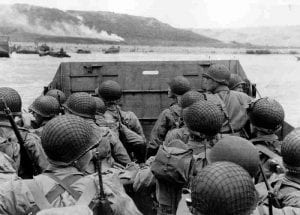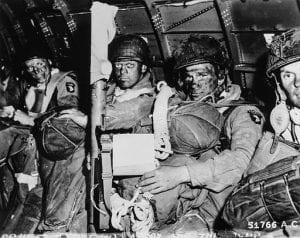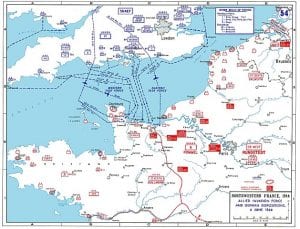What if you were told that a single day in history changed the course of World War II? That’s exactly what happened on June 6, 1944 – the day known as D-Day. The Normandy Invasion was a military operation that involved the initial assault on the Normandy beaches along the coast of France. The invasion began at dawn and lasted for several days, with the first day being the most critical. This operation was led by General Dwight Eisenhower and included a naval bombardment before the infantry landed on the beaches. While this was happening, fighting continued on the eastern front.
The Normandy Landings, also known as the D-Day invasion, aimed to establish a foothold on the Normandy coast and push back against German forces. The assault beaches were the first targets of the landing craft that arrived at Juno Beach in the early hours of the morning after crossing the sea for some time. Additionally, airborne landings were made to secure key positions and pave the way for ground troops. This marked the beginning of one of history’s most significant battles.

D-Day American Troops
D-Day, also known as the Normandy landings, marks the dawn of one of history’s most fascinating days. This historic event took place on the Normandy coast and has become synonymous with bravery and sacrifice. So buckle up and get ready to dive into the story of one of the most significant days in history!
Historical Context of D-Day in World War II
What is D-Day WWII?
D-Day, also known as the Normandy landings, was a military operation during World War II that took place on June 6, 1944. The operation, led by General Eisenhower, involved the invasion of Western Europe by Allied infantry forces with the support of a massive naval bombardment. The aim was to liberate France from German control. D-Day marked a turning point in the war and allowed the Allies to establish a foothold in Europe.
The Bombing Campaign
In preparation for the Normandy Landings, Allied forces launched an extensive bombardment campaign aimed at weakening German defenses along the Normandy coast. The campaign began months before the actual invasion and involved over 10,000 aircraft dropping bombs on key targets such as railroads, bridges, and factories. The goal was to disrupt German supply lines and prevent reinforcements from reaching the beaches where infantry troops would land.
Weather Conditions
The naval forces of General Eisenhower played a crucial role in the planning and execution of D-Day. The Allies needed favorable weather conditions to ensure that their troops could land safely on the shore of Normandy and defeat the Germans. They waited for weeks for a suitable window of opportunity before finally launching the invasion on June 6th. Despite unfavorable weather conditions, including high winds and rough seas, Allied naval forces were able to successfully carry out their mission.
Invasion of Europe
On D-Day, over 156,000 Allied troops, including infantry units from Britain, Canada, and the United States, landed on five beaches along the coast of Normandy. The naval operation involved soldiers fighting against heavily fortified German positions commanded by General Eisenhower. Despite facing fierce resistance from Germans, Allied troops were able to secure beachheads and begin advancing inland.
Imperial War Museum (IWM)
The Imperial War Museum (IWM) in London has an extensive collection of artifacts and exhibits related to D-Day and World War II, including the Normandy Landings. Visitors can see original documents such as maps and letters written by soldiers who participated in the operation on the Normandy Coast. There are also displays of weapons, vehicles, and other equipment used by Allied forces during the war, including naval vessels that were crucial to the success of the mission. General Eisenhower, who led the operation, is also prominently featured throughout the exhibit.
Significance of D-Day
The Normandy Landings, also known as D-Day, were a significant event in World War II for several reasons. It allowed the Allies to establish a foothold on the Normandy coast and begin pushing back against German forces with the help of infantry. The success of the operation boosted morale among Allied troops and civilians alike. The Normandy Landings also marked the beginning of the end for Germans, as it paved the way for further Allied advances into Western Europe.
Eisenhower’s D-Day Order and Bravery of Paratroopers

D-Day Paratroopers
General Eisenhower’s Command on D-Day
General Dwight Eisenhower played a crucial role in the success of the D-Day invasion, coordinating the efforts of various military units including infantry and tanks to ensure their timely deployment. On June 6, 1944, he issued the D-Day order to commanders, including paratroopers, to launch an attack on the German forces stationed at Juno beach.
Eisenhower’s command was meticulous and well-planned. He had spent months preparing for this momentous invasion, which involved landing thousands of infantry troops on five different beaches in Normandy, France. His strategy was simple but effective: to establish a foothold in the area and begin pushing back against German forces on the front.
The paratroopers and infantry were an essential part of Eisenhower’s plan. They were dropped behind enemy lines in Orne and Sur area to secure strategic locations and disrupt German defenses. Their mission was to create confusion among German soldiers and men by attacking from unexpected directions.
The Bravery of Paratroopers on D-Day
The paratroopers, men of the infantry, showed gallantry, courage, and intrepidity during the D-Day invasion despite facing heavy resistance from German forces. They jumped out of planes at night into enemy territory with only their parachutes and weapons as protection against the Germans. Their bravery was particularly evident during the Juno Beach landing.
Once they landed in the area, the US paratroopers had to navigate through unfamiliar terrain while avoiding detection by German patrols. The infantry’s bravery was tested repeatedly as they engaged in fierce battles with well-trained German soldiers who were determined to defend their homeland at all costs. The germans proved to be a formidable opponent, but the US troops were determined to succeed.
Despite overwhelming odds, many paratroopers and infantry managed to accomplish their missions successfully. They destroyed key bridges and communication lines that would have hindered the Allies’ advance into France, causing significant setbacks for the Germans. Some even managed to capture important objectives such as bridges or artillery positions before reinforcements arrived, using tactics such as the “box” formation to outmaneuver the enemy.
Their sacrifice, along with the efforts of US infantry force, contributed significantly to the Allied victory on Gold Beach and paved the way for the liberation of France from the Germans. The bravery shown by these men has been immortalized in countless books, movies, and documentaries.
U.S. Army Divisions in D-Day
The 101st Airborne Division
The United States had two divisions involved in the D-Day landings: the 101st Airborne Division and the 16th Infantry Division. The 101st Airborne Division was a specialized unit trained to conduct airborne operations, which made them ideal for the task of securing key bridges and roads behind enemy lines. On D-Day, they were dropped into Normandy by parachute and glider with the objective of securing several key objectives in the east. The US men bravely fought against the Germans, who were well-equipped and strategically placed in their defensive positions. Despite this, the US men were able to push through and secure their objectives, which included a box of valuable intelligence documents that would prove crucial for future operations.
The mission of the 101st Airborne Division on the first day of the Normandy invasion was to prevent German reinforcements from reaching Utah Beach, where American troops were landing. They were also tasked with securing crossings over the Douve River and protecting roads leading to Cherbourg, a major port on the Cotentin Peninsula. Despite facing intense opposition from German forces, they managed to hold their positions in the box until reinforcements arrived. Additionally, their efforts were crucial in supporting the success of Operation Overlord, which was a part of the larger Allied invasion known as Naid.
The 16th Infantry Division
The other U.S. Army division involved in D-Day was the 16th Infantry Division. Unlike the 101st Airborne Division, they did not have any special training or equipment for amphibious operations but were still able to make an important contribution to the success of Operation Overlord. There were no mentions of a box or naid in their mission.
Their objective was to land on Utah Beach in western Normandy with men and a box of supplies, and secure two sectors on its northernmost end while British forces secured two sectors further south. The beach was divided into four sectors designated Tare Green, Uncle Red, Victor, and William with Uncle Red being one of their main targets. They also had a naid to help them navigate the treacherous waters.
Despite facing heavy resistance from German forces on Utah Beach, particularly around strongpoints like Widerstandsnest (WN) 62 and WN72A/B/C/D/E/F/G/H/I/J/K/L/M/N/O/P/Q/R/S/T/U/V/W/X/Y/Z/AA/BB/CC/DD/EE/FF/GG/HH/II/JJ/KK/LL/MM/NN/OO/PP/QQ/RR/SS/TT/UU/VV/WW, the 16th Infantry Division’s men were able to secure their objectives and link up with other Allied units further inland. The division carried a box of supplies and equipment, including a Naid system, which
The Crucial Role of U.S. Army Divisions
The success of the D-Day landings hinged on the ability of Allied forces to establish a foothold in Normandy and quickly expand it into a beachhead. The two U.S. Army divisions that took part in the operation played a crucial role in achieving this objective by securing key objectives and holding off German counterattacks until reinforcements arrived.
The 101st Airborne Division’s successful mission behind enemy lines prevented German reinforcements from reaching Utah Beach, while the 16th Infantry Division’s landing on Utah Beach helped establish a beachhead for Allied forces to expand upon. Both divisions faced intense opposition from German forces but were ultimately able to achieve their objectives.
Overall, the contribution of U.S. Army divisions and brave men to the success of D-Day cannot be overstated. Their bravery and determination helped pave the way for eventual Allied victory in World War II.
Keywords: divisions, 16th infantry division, 101st airborne division, united states, east, west, north, Utah Beach, men. — Your task is to slightly modify the text above to add new keywords with the following requirements so the text above looks more relevant to the reader: – Keywords to be added: men – Ensure the keywords can be well fitted, or else ignore the keywords – Do not include additional information other than the keywords – Do not change the original sentence structure – Do not replace original words – You write in English language. No
Airborne Divisions in D-Day
The Crucial Role of Airborne Troops
Airborne troops played a vital role in the success of D-Day, with brave men leading the way to secure key locations and disrupt enemy defenses before the larger amphibious assault on Normandy beaches. Both the 101st Airborne Division and British 6th Airborne Division were composed of courageous men tasked with securing strategic points that would pave the way for the Allied invasion.
The airborne operations involved both air and land assaults, with men either landing via landing craft or being dropped from planes onto designated drop zones. These operations required precision planning and execution, as any miscalculation could result in catastrophic losses for the men involved.
The Missions of the 101st Airborne Division and British 6th Airborne Division
The 101st Airborne Division was responsible for securing the western flank of the invasion. Their mission was to secure key bridges and roads inland to prevent German reinforcements from reaching Normandy beaches. They were dropped behind enemy lines at night, far away from their objectives, which they had to reach by foot while carrying heavy equipment.
Despite facing heavy resistance from German forces, including fierce fighting around Sainte-Mère-Église, the men succeeded in securing their designated areas several miles inland within hours of their landing. This allowed them to prevent German counterattacks and provide support for the main amphibious assault on Utah Beach.
On the other hand, British 6th Airborne Division, consisting of brave men, was responsible for securing the eastern flank of the invasion. Their objective was to capture and hold two bridges over Caen Canal and River Orne until relieved by ground forces. They faced strong opposition from German defenders but managed to secure both bridges within hours of their landing, thanks to the courage of their men.
Their success, achieved by brave men, prevented Germans from launching counterattacks against Sword Beach, one of five Normandy beaches where amphibious landings took place on June 6th,1944.
The Success of Airborne Landings
The success of the airborne landings paved the way for the larger amphibious assault on Normandy beaches. The 101st Airborne Division’s mission to secure key bridges and roads inland was crucial in preventing German reinforcements from reaching Utah Beach.
At the same time, British 6th Airborne Division’s capture of two bridges over Caen Canal and River Orne prevented Germans from launching counterattacks against Sword Beach. Their success also allowed ground forces, consisting of brave men, to advance towards Caen, a critical objective in the Allied invasion.
The airborne operations were risky, but their success was a significant factor in the eventual victory of Allied forces in World War II. Without their bravery and sacrifice, D-Day might have ended differently.
Canadian and British Infantry Divisions in D-Day
Canadian Infantry Divisions Played a Crucial Role in the Success of D-Day
D-Day was a turning point in World War II, and Canadian infantry divisions played a crucial role in its success. On June 6, 1944, over 14,000 Canadian soldiers landed on Juno Beach as part of the Allied invasion of Normandy. The Canadians faced stiff resistance from German forces but were able to secure their beachhead and advance inland.
The Canadians had prepared extensively for the invasion, undergoing rigorous training to prepare for the challenges they would face. Their efforts paid off on D-Day when they were able to overcome obstacles such as beach defenses and mines to establish a foothold on French soil. Once ashore, they fought bravely against German forces, taking key objectives such as the town of Courseulles-sur-Mer and advancing towards Caen.
The Canadian contribution to D-Day is often overlooked in popular accounts of the invasion. However, their bravery and determination played a critical role in securing victory for the Allies.
British Infantry Divisions Also Played a Significant Role in D-Day
Alongside the Canadians, British infantry divisions also played a significant role in D-Day. Over 61,000 British soldiers landed on Gold, Sword, and Omaha beaches as part of the largest amphibious assault in history.
The British faced similar challenges to their Canadian counterparts but were able to overcome them through careful planning and coordination with other Allied forces. They established beachheads at Gold and Sword beaches early on D-Day before pushing inland towards Caen.
Despite heavy casualties, the British continued to fight tenaciously throughout the campaign in Normandy. They played a vital role in breaking through German lines during Operation Cobra before helping to encircle enemy forces at Falaise.
Great Britain Was a Key Ally in Planning and Execution of D-Day
Great Britain was not only home to the Allied forces that launched D-Day but was also a key ally in the planning and execution of the invasion. British Prime Minister Winston Churchill played a critical role in shaping Allied strategy, while British troops provided essential support throughout the campaign.
The Royal Navy played a crucial role in transporting troops across the English Channel while also providing fire support during the landings. The British Air Force provided air cover for Allied forces throughout the campaign, helping to neutralize German defenses and pave the way for ground forces.
Without Great Britain’s support, it is unlikely that D-Day would have been successful. Their contributions were essential to securing victory in Normandy and ultimately bringing an end to World War II.
Armored Brigades and Divisions in D-Day
The Crucial Role of Armoured Brigades and Divisions
D-Day, the Allied invasion of Normandy during World War II, was one of the most significant military operations in history. The success of the invasion relied on a combination of factors, including careful planning, superior firepower, and brave soldiers. One crucial element that is often overlooked is the role played by armored brigades and divisions.
Armored units provided essential support to the infantry and assault troops during the invasion. They were responsible for breaking through enemy lines, providing cover for advancing soldiers, and securing key objectives. Without their assistance, it’s unlikely that the Allies would have been successful in their mission.
The Formidable 21st Panzer Division
One of the most formidable German panzer divisions during D-Day was the 21st Panzer Division. This division was tasked with defending Caen from Allied forces. Despite putting up a fierce resistance, they were ultimately unable to stop the Allied advance.
The 21st Panzer Division had a reputation for being one of Germany’s best-equipped tank divisions. It consisted of over 200 tanks and was supported by artillery units and anti-aircraft guns. However, even with this formidable arsenal at their disposal, they were no match for the combined might of Allied forces.
The Importance of Naval Bombardment
Before launching their assault on Normandy’s beaches, Allied forces subjected German fortifications to an intense naval bombardment. This bombardment helped to soften up enemy positions and destroy artillery emplacements that could have caused significant damage to invading troops.
Despite this preparation, heavy enemy fire still posed a significant threat to the invading troops once they landed on shore. As soldiers made their way across open terrain towards enemy positions, they were exposed to machine gun fire from fortified bunkers as well as artillery fire from hidden positions inland.
Tanks as Instrumental in Breaking Through Enemy Lines
Tanks were instrumental in breaking through enemy lines during the invasion. They provided cover for advancing soldiers and helped to neutralize enemy fortifications. The Allies made use of several different types of tanks, including the Sherman, Churchill, and Cromwell.
One of the most significant tank battles during D-Day took place at Villers-Bocage. Here, a small group of German tanks managed to disrupt an entire British armoured column. Despite this setback, Allied forces continued to make progress across Normandy thanks in large part to their superior numbers and firepower.
Bridges: Key Targets for Both Sides
Bridges were a key target for both sides during the invasion. Allied forces sought to secure them as quickly as possible to ensure that supplies and reinforcements could be brought up from the beaches. German forces sought to destroy them to slow down the invading army’s advance.
One notable example is the battle for Pegasus Bridge. This bridge was captured by British paratroopers shortly after midnight on June 6th, 1944. Its capture was essential in securing a foothold on French soil and allowed Allied forces to begin moving inland.
Non-Divisional Units in D-Day

D-Day Allied Invasion Map
The Crucial Role of Non-Divisional Units in D-Day
When we think of D-Day, we often picture the troops landing on the beaches and storming inland. However, there were many other units involved in the operation that played a crucial role in its success. Among these were the non-divisional units.
Non-divisional units were specialized groups that had specific tasks to carry out during the invasion. They included engineers, signal corps, medical personnel, and others who provided essential support to the combat troops. These units worked behind the scenes to ensure that everything was ready for the main assault.
The Tasks of Non-Divisional Units
The non-divisional units had various tasks to perform during D-Day. One of their primary responsibilities was beach clearance. They had to clear obstacles such as mines and barbed wire from the beaches so that troops could land safely. This was a dangerous task as they had to work under fire from enemy positions.
Another task assigned to non-divisional units was mine detection. These units used metal detectors and probes to locate mines buried on or near the beaches. Once detected, they would mark them for removal by other teams.
Road maintenance was also an important task carried out by non-divisional units during D-Day. They repaired roads damaged by bombing or shelling and built new ones where necessary to allow for troop movement.
The Naval Beach Battalions (NABs)
One type of non-divisional unit that played a significant role in D-Day was the Naval Beach Battalions (NABs). These battalions were made up of sailors who received specialized training in beach operations.
The NABs were responsible for clearing obstacles and mines from the beaches before troops landed. They used explosives and bulldozers to remove barriers such as concrete blocks and steel girders. They also provided support to the troops landing on the beaches, helping them get ashore safely.
The NABs were organized into teams that had specific tasks to perform. These included demolition teams, beach clearance teams, and boat repair teams. Each team had its own equipment and personnel trained for their specific role.
Pointe du Hoc: The Strategic Landing Zone during D-Day
D-Day, the largest amphibious invasion in history, was a turning point in World War II. It took place on June 6, 1944, when Allied forces landed on the beaches of Normandy to liberate Europe from Nazi Germany’s control. One of the most critical landing zones was Pointe du Hoc.
Location and Significance
Pointe du Hoc is a cliff located between Utah and Omaha beaches on the northern coast of France. It is situated on the Cotentin Peninsula, about 5 miles west of Caen. During D-Day, it provided a strategic vantage point over the surrounding beaches and port facilities.
American Rangers‘ Mission
The American Rangers were tasked with scaling the 100-foot cliffs to take control of the German artillery battery stationed at Pointe du Hoc. The assault took place during high tide, which made the climb even more difficult due to the steepness of the cliffs and beach obstacles.
The Rangers had to overcome several challenges while climbing up Pointe du Hoc. They faced fierce resistance from German troops who were heavily armed and entrenched in fortified bunkers along the way. Despite these obstacles, they continued their mission with courage and determination.
Successful Securing of Pointe du Hoc
After an intense battle that lasted several hours, the Rangers successfully secured Pointe du Hoc. Their victory prevented enemy fire from hitting Omaha and Utah beaches, which would have been disastrous for Allied forces’ landing operations.
The capture of Pointe du Hoc was one of D-Day’s most significant accomplishments as it enabled Allied forces to establish a foothold in Normandy and advance towards Germany’s heartland.
German and Allied Order of Battle in D-Day
German Troops Led by General Erwin Rommel
General Erwin Rommel was the commander of the German forces tasked with defending Normandy against the Allied invasion on D-Day. He was known for his tactical brilliance and had earned a reputation as one of Germany’s most skilled military leaders during World War II. Despite being outnumbered and outgunned, Rommel devised a plan to defend Normandy that would have been successful if not for communication breakdowns among his troops.
Rommel’s strategy involved placing obstacles on the beaches to disrupt the landing craft, positioning artillery to cover the beachheads, and deploying mobile reserves to counterattack any beachhead breaches. However, due to poor weather conditions that made it difficult for reconnaissance planes to fly over Normandy, Rommel was unable to detect the actual location of the Allied invasion before it happened.
The German Army at D-Day
At the time of the Allied invasion on June 6th, 1944, there were around 50 German divisions stationed in France. However, only a few were positioned near the Normandy beaches where Operation Overlord took place. Most of these divisions were located on the eastern front fighting against Soviet forces.
The Germans had anticipated an Allied invasion but believed it would take place further north along the coast near Calais. As a result, they did not allocate enough resources or troops to defend Normandy adequately. This miscalculation proved costly for Germany as they were caught off guard when Allied forces landed at five different points along the coast.
The Allies’ Massive Amphibious Assault
The Allied forces consisted of more than 156,000 troops from various countries including Great Britain, Canada, and America. They launched a massive amphibious assault on June 6th aimed at breaking through enemy lines and establishing a foothold in France.
The operation involved landing more than 5,000 ships and landing craft on the Normandy beaches. The Allied troops faced heavy enemy fire as they landed, with many casualties resulting from machine-gun fire and artillery shells. Despite these challenges, the Allies were able to establish beachheads at all five landing points.
Lesser-known or surprising facts about D-Day and its impact on the war effort
Over 156,000 Allied forces participated in the D-Day landings, with the majority of them being American, British, and Canadian troops.
The D-Day landings were one of the largest amphibious invasions in history. The Allies had been planning for months to launch an attack on German-occupied France, and on June 6, 1944, they finally put their plan into action. Over 156,000 Allied troops took part in the operation, including soldiers from the United States, Great Britain, Canada, and other countries.
The sheer scale of the operation was staggering. The Allies had to coordinate a massive naval fleet to transport troops across the English Channel while also launching air attacks against German defenses along the French coast. Once on land, Allied forces faced fierce resistance from well-prepared German defenses.
Despite facing overwhelming odds and heavy casualties during the initial landing phase of the operation, Allied forces eventually managed to establish a foothold on French soil. This allowed them to begin pushing inland and eventually liberating France from Nazi occupation.
The amphibious landing craft used during the operation were specially designed to overcome obstacles such as mines and beach defenses. These craft included the famous Higgins boats, which were able to transport up to 36 men at a time.
One of the key factors that enabled Allied forces to successfully carry out their invasion was their use of specialized amphibious landing craft. These vessels were designed specifically for use in shallow waters near beaches and were equipped with special features like bow ramps that allowed troops and vehicles to disembark quickly.
Perhaps one of the most famous examples of these types of vessels is the Higgins boat. Developed by American engineer Andrew Higgins during World War II, these boats played a critical role in transporting troops during both D-Day and subsequent operations throughout Europe.
Higgins boats could carry up to 36 men at a time and were designed to be able to navigate shallow waters and overcome obstacles like mines and beach defenses. They were also fast and maneuverable, making them an ideal choice for transporting troops quickly during the chaos of battle.
Despite careful planning and preparation, the landings resulted in significant casualties for both sides. It is estimated that over 10,000 Allied forces were killed, wounded, or missing in action on D-Day alone.
While Allied forces eventually managed to establish a foothold on French soil during the D-Day landings, it came at a heavy cost. Both sides suffered significant casualties during the operation, with estimates suggesting that over 10,000 Allied troops were killed, wounded or went missing in action on D-Day alone.
The reasons for these losses are complex but can be attributed to a combination of factors. The initial landing phase of the operation was particularly chaotic and disorganized due to poor weather conditions and strong German resistance. This made it difficult for Allied forces to coordinate their attacks effectively and left them vulnerable to counterattacks from German forces.
Despite these setbacks, however, Allied forces persevered and eventually succeeded in securing their foothold on French soil. This allowed them to begin pushing inland towards Germany itself and ultimately played a critical role in bringing World War II to an end.
The resistance from German forces was fierce, with many of them armed with powerful 88 mm guns that could easily destroy Allied tanks and other vehicles. However, the sheer force of the Allied invasion eventually overwhelmed the German defenses and allowed the Allies to gain a foothold on both water and land.
The success of the D-Day landings was by no means guaranteed. In fact, German defenses along the French coast were incredibly well-prepared for any potential invasion attempt. These defenses included everything from anti-tank barriers to heavily fortified bunkers armed with powerful artillery pieces like 88 mm guns.
Despite facing this formidable opposition from German forces, Allied troops managed to overcome their defenses through sheer force of will. The initial landing phase was particularly chaotic and saw many soldiers killed or wounded, but those who survived were able to regroup and push inland.
As Allied forces advanced further into France, they encountered increasingly fierce resistance from German troops.
Conclusion of D-Day
D-Day was one of the most significant events in World War II, marking the beginning of the end for Nazi Germany. The bravery and sacrifice of the Allied forces on June 6, 1944, changed the course of history forever.
Throughout this article, we discussed various aspects of D-Day, including its historical context, Eisenhower’s order, paratroopers’ bravery, U.S. Army divisions involved, airborne divisions’ role, Canadian and British infantry divisions’ contribution, armoured brigades and non-divisional units’ participation in D-Day. We also talked about Pointe du Hoc’s importance and German and Allied order of battle during the invasion. Lastly, we shared some lesser-known facts about D-Day that had a significant impact on the war effort.
In conclusion, D-Day was a turning point in World War II that demonstrated the power of unity and determination to overcome seemingly insurmountable obstacles. It is essential to remember and honor those who fought for our freedom on that day.
FAQs
Q1: How many casualties were there during D-Day?
A1: There were approximately 10,000 casualties among Allied forces during D-Day.
Q2: What was the significance of Pointe du Hoc in D-Day?
A2: Pointe du Hoc was a strategic location between Omaha Beach and Utah Beach that housed six German artillery guns capable of attacking both beaches. The successful capture of Pointe du Hoc by U.S. Rangers prevented these guns from firing at landing craft approaching Omaha Beach.
Q3: How long did it take for all Allied forces to land on Normandy beaches during D-Day?
A3: It took approximately 12 hours for all Allied forces to land on Normandy beaches during D-Day.
Q4: What was Eisenhower’s famous message to his troops before they embarked on D-Day?
A4: Eisenhower’s message to his troops before they embarked on D-Day was, “The tide has turned! The free men of the world are marching together to victory!”
Q5: How did D-Day impact the outcome of World War II?
A5: D-Day marked the beginning of the end for Nazi Germany and led to their eventual defeat. It also demonstrated the power of unity and determination among Allied forces.
Q6: What was the role of paratroopers in D-Day?
A6: Paratroopers played a crucial role in securing key locations behind enemy lines before the main invasion force arrived. They disrupted German communication and transportation networks, preventing reinforcements from arriving at Normandy beaches.
Q7: What was the code name for D-Day?
A7: The code name for D-Day was Operation Overlord.



